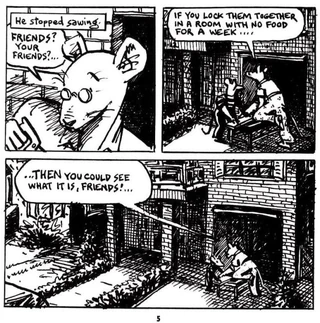Early Life[]

Spiegelman Family retrieved from http://mrcoward.com/slcusd/vladekartanja.jpg
Influential artist and graphic novelist he was born February 15, 1948 in Stockholm, Sweden. His parents were Polish Jews who survived the death camps of the Holocaust, so after a few years the family migrated to America soon after in 1957. Art began cartooning in 1960 and was influenced by comic books such as Mad, television wasn't around at the time so comics helped introduced the world to him. And by the time he reached high school, he was earning money from his drawings. Majoring in Cartooning, he meets the art director of Topps Chewing Gum Co., and recommends him to apply once he graduates high school. His parents wish for him to become a dentist, but he ended up studying art and philosophy at Harpur College in Upstate New York. He freelanced on art jobs at Topps, worked as a cartoonist for the college newspaper and various other magazines. However, left two years later without a degree following a nervous breakdown, but shortly after learned that his mother Anya Spiegelman committed suicide.
He began a major movement, by publishing his own artworks in underground magazines such as, Gothic Blimp Works, Bijou Funnies, Young Lust, Real Pulp and Bizarre Sex. In 1972 Spiegelman was asked to do a three-page strip for Funny Animals, he considered a story with African-Americans as mice dealing with racism. However, not having enough information, he turned to his parents knowing that they had survived the Holocaust. The strip was called "Maus". The Jews were depicted as mice, and the Nazis depicted as cats. It was with this story that Spiegelman felt he had found his voice.
by Raymond Tonga
Historial Context of growing up[]

Maus comic panel retrieved from https://mausandthemask.wordpress.com/art-v-art-spiegelman/
Maus was to tell directly what happened to his father & mother and it how his relationship was with his parents. Even though it's about the story of Vladek experiences in the Holocaust, it also more about the relationship between Valdek and his son. Art Spiegelman parents Wladyslaw and Andzia were Polish Jews, however they changed their names to Vladek and Anja, for easier pronunciation. Spiegelman wasn’t overwhelmed by thoughts of the death camp at a young age, it wasn’t unusual. Aware of the idea, it became part of his life; however he was aware that he used to have a brother named Rysio, who died around 5 or 6 before Spiegelman was born. During the Holocaust Spiegelman parents sent Rysio to live with his aunt, however she poisoned everyone so the Nazis wouldn't take them. Spiegelman would talk about having a sibling rivalry with his dead brother ““The photo never threw tantrums or got in any kind of trouble … it was an ideal kid, and I was a pain in the ass. I couldn’t compete.” (I5) Spiegelman would feel that he wasn't enough to be a good son. There would be moment of arguments between father and son, and they do not see each other even though they live close, however making Maus was a way for Spiegelman to learn more about his parents
by Raymond Tonga
Adult Life[]

Spiegelman's life has been closely involved with the twin towers incident of September 11th. Since residing close by in New York, he and his family had the horrors of experiencing it at a closer distance than many others who have witnessed it though a screen. Through it, he has created the comic called In the Shadows of No Towers in 2004 and once again enlightened and educated people of major happenings as he had done so with Maus. In 2005, Time magazine had listed him on the list of 100 Most Influential artists of all time through his work and publishing of Maus and the impact Maus had made on the society. Currently, jumping from several publishing companies with noteable ones being The New Yorker, Playboy and New York Times, Spiegelman has continued to locate himself in New York with his wife and two daughters and has lived in the footsteps of Maus with his charitable activities.
by Lydia Baek
References[]
"Art Spiegelman." ADC Hall of Fame. N.p., 2006. Web. 29 Nov. 2015. <http://adcglobal.org/hall-of-fame/art-spiegelman/>.
Ray, Michael. "Art Spiegelman." Encyclopedia Britannica Online. Encyclopedia Britannica, n.d. Web. 30 Nov. 2015. <http://www.britannica.com/biography/Art-Spiegelman>.
Lederman, Marsha. "Art Spiegelman Retrospective."
The Globe and Mail. N.p., Jan.-Feb. 2013. Web. 30 Nov. 2015.
<http://www.theglobeandmail.com/arts/art-and-architecture/art-spiegelman-retrospective-a-look-back-on-a-career-thats-been-all-about-looking-back/article8715508/>.
"Art Spiegelman." Lambiek.net. N.p., n.d.
Web. 30 Nov. 2015.
<https://www.lambiek.net/artists/s/spiegelman.htm>.
"Maus Questions and Resources Page, Prof. Marcuse, UCSB." Maus Questions and Resources Page, Prof. Marcuse, UCSB. N.p., n.d. Web. 30 Nov. 2015. <http://www.history.ucsb.edu/faculty/marcuse/classes/33d/33dTexts/maus/MausResources.htm#timeline>.
"Art Spiegelman Biography | List of Works, Study Guides & Essays." Art Spiegelman Biography. N.p., n.d. Web. 30 Nov. 2015.